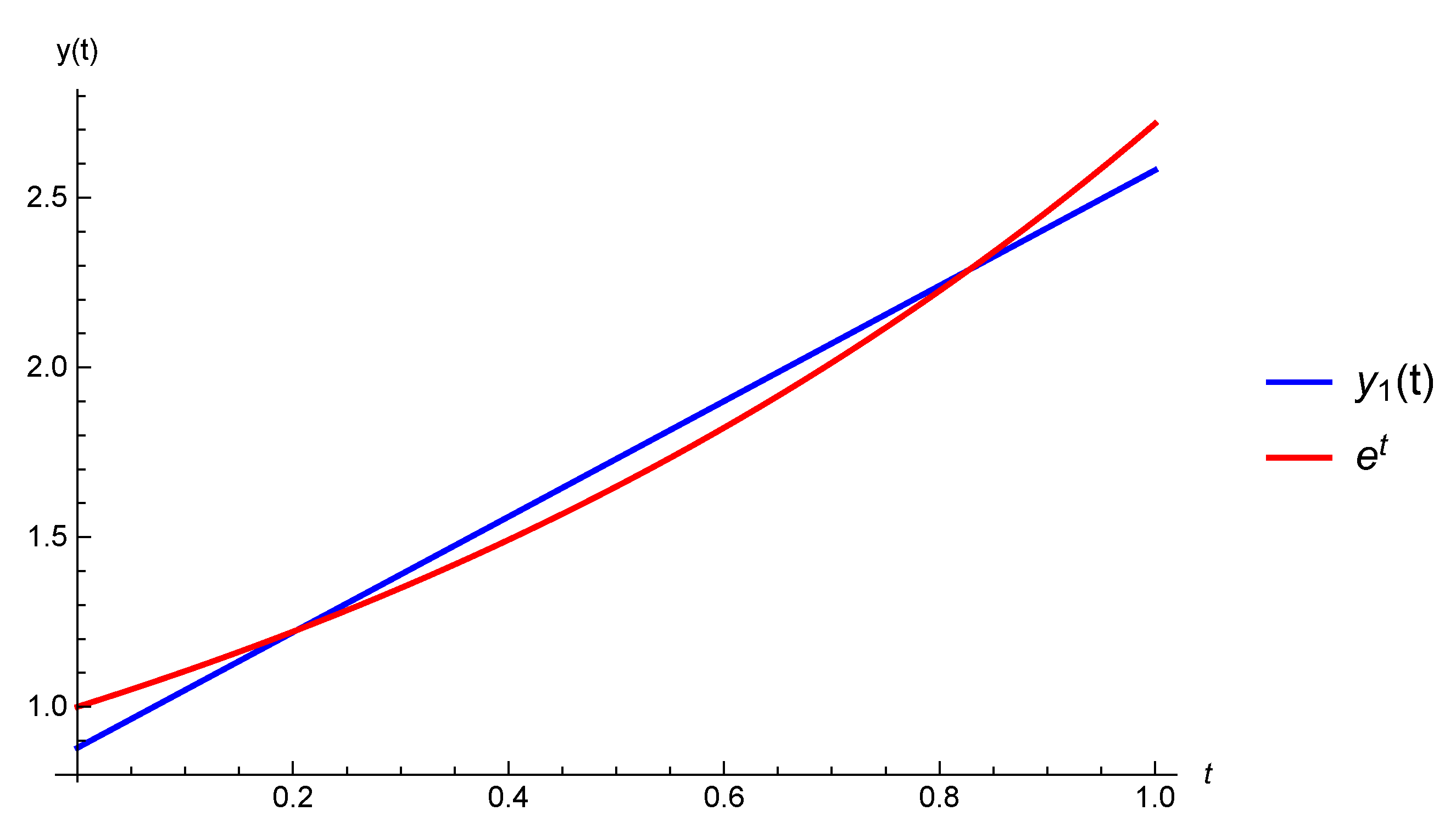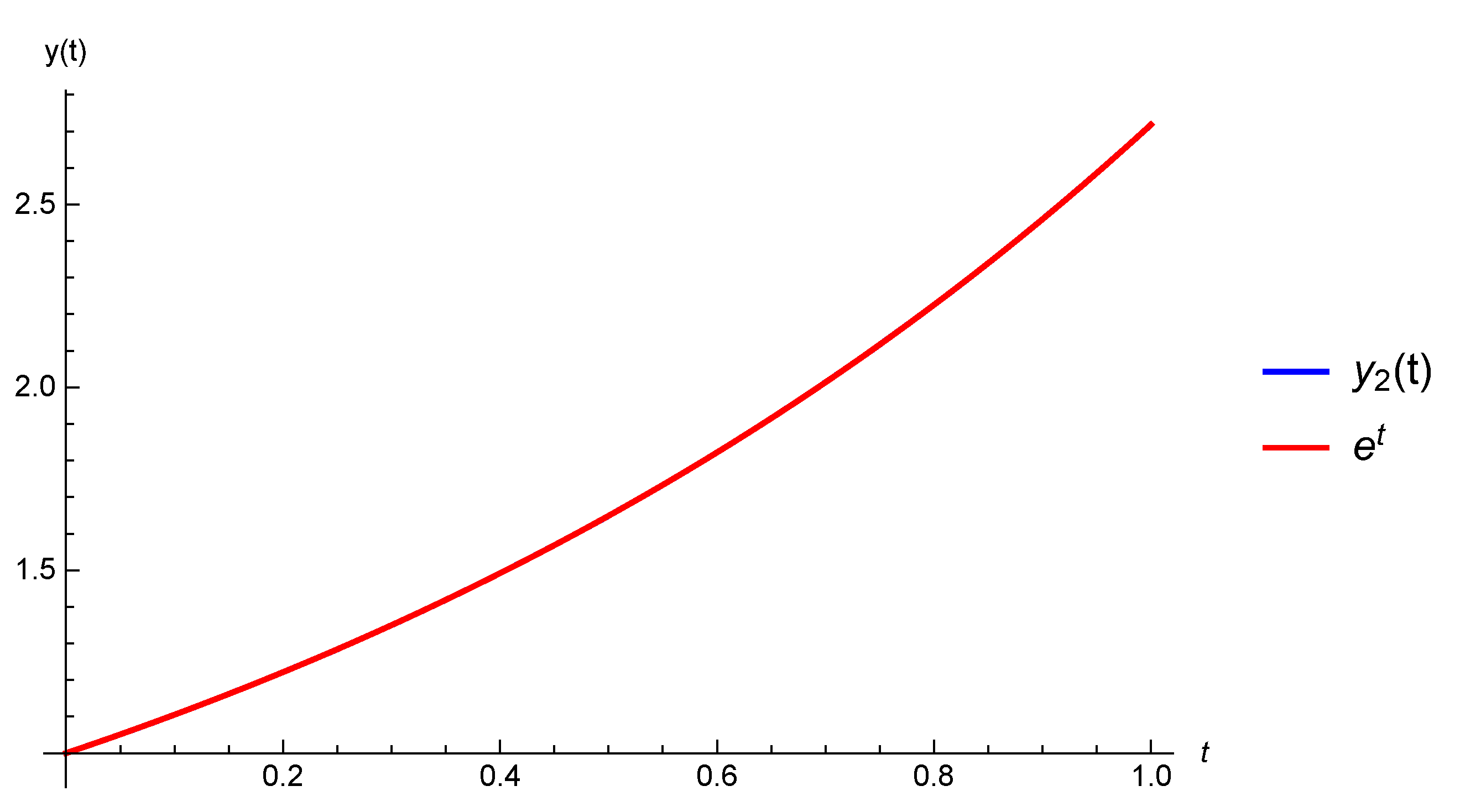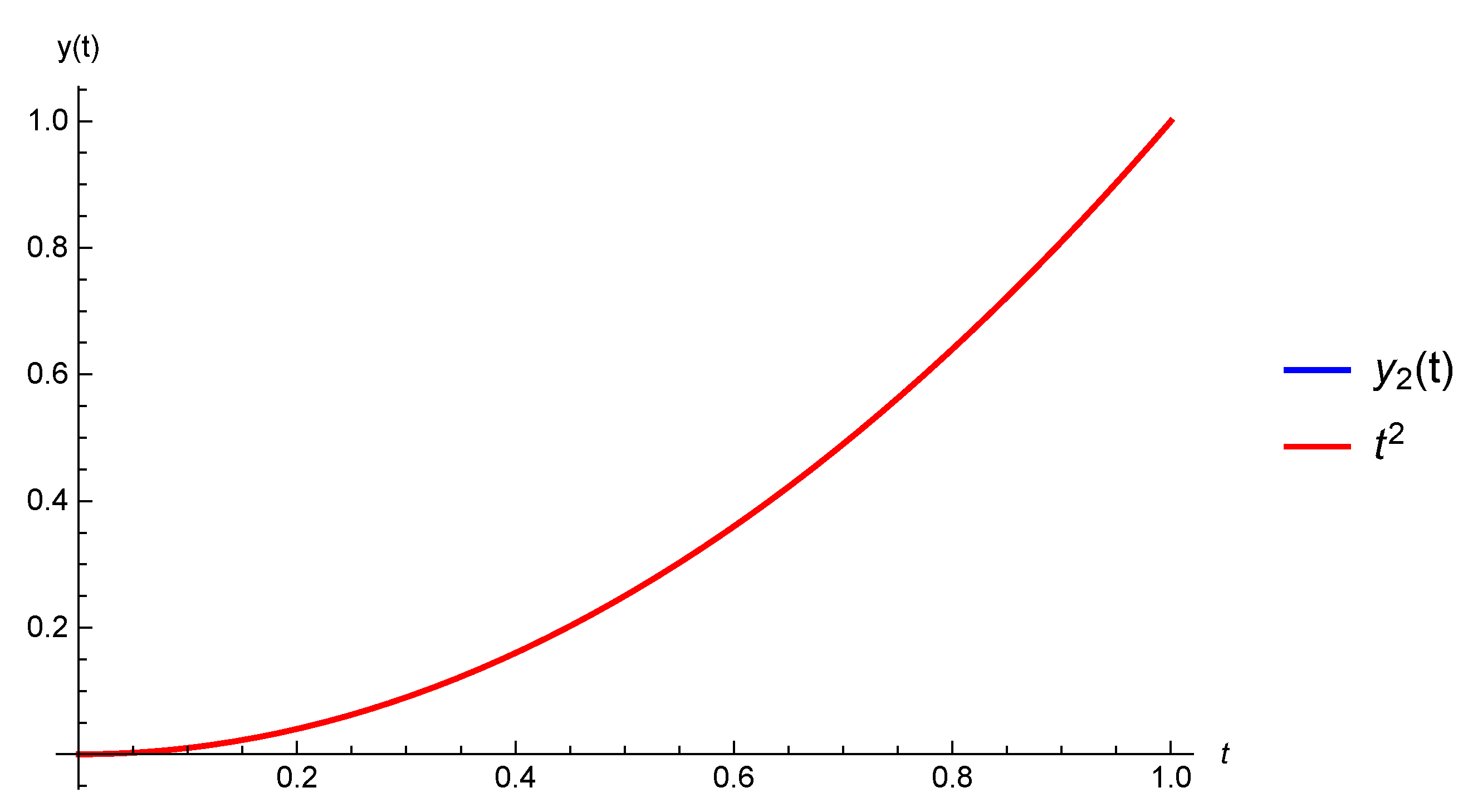A Hybrid Function Approach to Solving a Class of Fredholm and Volterra Integro-Differential Equations
Abstract
1. Introduction
2. Preliminaries
3. Main Results
3.1. Approximated Solution of the Fredholm Integro-Differential System (3)
3.2. Approximated Solution of the Volterra Integro-Differential System (4)
4. Error Analysis
5. Numerical Examples
Comparison with Other Methods
6. Conclusions
Author Contributions
Acknowledgments
Conflicts of Interest
References
- Bloom, F. Asymptotic bounds for solutions to a system of damped integro-differential equations of electromagnetic theory. J. Math. Anal. Appl. 1980, 73, 524–542. [Google Scholar] [CrossRef]
- Holmaker, K. Global asymptotic stability for a stationary solution of a system of integro-differential equations describing the formation of liver zones. SIAM J. Math. Anal. 1993, 24, 116–128. [Google Scholar] [CrossRef]
- Abdou, M.A. On asymptotic methods for Fredholm–Volterra integral equation of the second kind in contact problems. J. Comput. Appl. Math. 2003, 154, 431–446. [Google Scholar] [CrossRef]
- Forbes, L.K.; Crozier, S.; Doddrell, D.M. Calculating current densities and fields produced by shielded magnetic resonance imaging probes. SIAM J. Appl. Math. 1997, 57, 401–425. [Google Scholar]
- Delves, L.M.; Mohamed, J.L. Computational Methods for Integral Equations; Cambridge University Press: Cambridge, UK, 1985. [Google Scholar]
- Basirat, B.; Maleknejad, K.; Hashemizadeh, E. Operational matrix approach for the nonlinear Volterra–Fredholm integral equations: Arising in physics and engineering. Int. J. Phys. Sci. 2012, 7, 226–233. [Google Scholar]
- Wazwaz, A.M. A First Course in Integral Equations; World Scientifics: Singapore, 1997. [Google Scholar]
- Polyanin, A.D.; Manzhirov, A.V. Handbook of Integral Equations, 2nd ed.; Chapman and Hall/CRC Press: London, UK, 2008. [Google Scholar]
- Golberg, M.A. The convergence of a collocations method for a class of Cauchy singular integral equations. J. Math. Appl. 1984, 100, 500–512. [Google Scholar] [CrossRef][Green Version]
- Kovalenko, E.V. Some approximate methods for solving integral equations of mixed problems. Probl. Math. Mech. 1989, 53, 85–92. [Google Scholar] [CrossRef]
- Semetanian, B.J. On an integral equation for axially symmetric problem in the case of an elastic body containing an inclusion. J. Appl. Math. Mech. 1991, 55, 371–375. [Google Scholar] [CrossRef]
- Willis, J.R.; Nemat-Nasser, S. Singular perturbation solution of a class of singular integral equations. Quart. Appl. Math. 1990, XLVIII, 741–753. [Google Scholar] [CrossRef][Green Version]
- Frankel, J. A Galerkin solution to regularized Cauchy singular integro-differential equation. Q. Appl. Math. 1995, 52, 145–258. [Google Scholar] [CrossRef]
- Golbabai, A.; Javidi, M. Application of He’s homotopy perturbation method for nth-order integro-differential equations. Appl. Math. Comput. 2007, 190, 1409–1416. [Google Scholar] [CrossRef]
- Shang, X.; Han, D. Application of the variational iteration method for solving nth-order integro-differential equations. J. Comput. Appl. Math. 2010, 234, 1442–1447. [Google Scholar] [CrossRef]
- Abbasbandy, S.; Shivanian, E. Application of variational iteration method for nth-order integro-differential equations. Zeitschrift fur Naturforschung A 2009, 64, 439–444. [Google Scholar] [CrossRef]
- Hou, J.; Yang, C. Numerical method in solving Fredholm integro-differential equations by using hybrid function operational matrix of derivative. J. Inf. Comput. Sci. 2013, 10, 2757–2764. [Google Scholar] [CrossRef]
- Hemeda, A.A. New iterative method: Application to nth-order integro-differential equations. Int. Math. Forum 2012, 7, 2317–2332. [Google Scholar]
- Daftardar-Gejji, V.; Jafari, H. An iterative method for solving non-linear functional equations. J. Math. Anal. Appl. 2006, 316, 753–763. [Google Scholar] [CrossRef]
- Marzban, H.R.; Razzaghi, M. Optimal control of linear delay systems via hybrid of block-pulse and Legendre polynomials. J. Franklin Inst. 2004, 341, 279–293. [Google Scholar] [CrossRef]
- Razzaghi, M.; Marzban, H.R. A hybrid analysis direct method in the calculus of variations. Int. J. Comput. Math. 2000, 75, 259–269. [Google Scholar] [CrossRef]
- Hsiao, C.H. Hybrid function method for solving Fredholm and Volterra integral equations of the second kind. J. Comput. Appl. Math. 2009, 230, 59–68. [Google Scholar] [CrossRef]
- Maleknejad, K.; Basirat, B.; Hashemizadeh, E. Hybrid Legendre polynomials and block-pulse functions approach for nonlinear Volterra–Fredholm integro-differential equations. Comput. Math. Appl. 2011, 61, 282–288. [Google Scholar] [CrossRef]
- Mizaee, F. Numerical solution of system of linear integral equations via improvement of block-pulse functions. J. Math. Model. 2016, 4, 133–159. [Google Scholar]
- Mizaee, F.; Alipour, S. Approximate solution of nonlinear quadratic integral equations of fractional order via piecewise linear functions. J. Comput. Appl. Math. 2018, 331, 217–227. [Google Scholar] [CrossRef]
- Mizaee, F.; Alipour, S.; Samadyar, N. Numerical solution based on hybrid of block-pulse and parabolic functions for solving a system of nonlinear stochastic Ito–Volterra integral equations of fractional order. J. Comput. Appl. Math. 2019, 349, 157–171. [Google Scholar] [CrossRef]
- Mizaee, F.; Hoseini, S.F. A new collocation approach for solving systems of high-order linear Volterra integro-differential equations with variable coefficients. Appl. Math. Comput. 2017, 311, 272–282. [Google Scholar]
- Mizaee, F.; Hoseini, S.F. Hybrid functions of Bernstein polynomials and block-pulse functions for solving optimal control of the nonlinear Volterra integral equations. Indag. Math. 2016, 27, 835–849. [Google Scholar] [CrossRef]
- Hashemizadeh, E.; Basirat, B. An efficient computational method for the system of linear Volterra integral equations by means of hybrid functions. Math. Sci. 2011, 5, 355–368. [Google Scholar]
- Shojaeizadeh, T.; Abadi, Z.; Golpar Raboky, E. Hybrid functions approach for solving Fredholm and Volterra integral equations. J. Prime Res. Math. 2009, 5, 124–132. [Google Scholar]
- Which Method Does Mathematica Use in NSolve for One Variable Functions? Available online: https://community.wolfram.com/groups/-/m/t/116219 (accessed on 22 May 2020).
- Stewart, G.W. Afternotes on Numerical Analysis; SIAM: Philadelphia, PA, USA, 1996; Volume 49. [Google Scholar]
- Kumar, M.; Jhinga, A.; Daftardar-Gejji, V. New algorithm for solving non-linear functional equations. Int. J. Appl. Comput. Math. 2020, 6, 26. [Google Scholar] [CrossRef]
- Adomian, G. Solving Frontier Problems of Physics: The Decomposition Method; Springer Science and Business Media: Dordrecht, The Netherlands, 2013; Volume 60. [Google Scholar]
- Van der Houwen, P.J.; Wolkenfelt, P.H.M. On the stability of multistep formulas for Volterra integral equations of the second kind. Computing 1980, 24, 341–347. [Google Scholar] [CrossRef]
- Ray, S.S.; Sahu, P.K. Numerical methods for solving Fredholm integral equations of second kind. Abstr. Appl. Anal. 2013, 2013, 426916. [Google Scholar] [CrossRef]




| t | Error | t | Error |
|---|---|---|---|
| 0.0 | 0.120825 | 0.5 | 0.08146 |
| 0.1 | 0.05579 | 0.6 | 0.07827 |
| 0.2 | 0.00182 | 0.7 | 0.05683 |
| 0.3 | 0.03992 | 0.8 | 0.01525 |
| 0.4 | 0.06816 | 0.9 | 0.04861 |
| t | Error | t | Error |
|---|---|---|---|
| 0.0 | 0.000145961 | 0.5 | 0.000240649 |
| 0.1 | 0.0000409679 | 0.6 | 0.0000675446 |
| 0.2 | 0.0000553281 | 0.7 | 0.0000912206 |
| 0.3 | 0.0000656897 | 0.8 | 0.000108304 |
| 0.4 | 0.0000536172 | 0.9 | 0.0000883998 |
| t | Error | t | Error |
|---|---|---|---|
| 0.0 | 0.0000221689 | 0.5 | 0.0000975226 |
| 0.1 | 8.9 | 0.6 | 0.0000429716 |
| 0.2 | 4.99 | 0.7 | 4.32 |
| 0.3 | 3 | 0.8 | 3.76 |
| 0.4 | 0.0000271471 | 0.9 | 0.0000547743 |
| t | Error | t | Error |
|---|---|---|---|
| 0.0 | 0 | 0.5 | 0.0214405 |
| 0.1 | 0.014372 | 0.6 | 0.0236955 |
| 0.2 | 0.0158835 | 0.7 | 0.0261875 |
| 0.3 | 0.017554 | 0.8 | 0.0289417 |
| 0.4 | 0.0194002 | 0.9 | 0.0319855 |
| t | DGJ/ADM Error | Quadrature Rule Error | t | DGJ/ADM Error | Quadrature Rule Error |
|---|---|---|---|---|---|
| 0.0 | 0 | 0 | 0.5 | 0.0000486807 | 0.0000509481 |
| 0.1 | 1.24837 | 4.06185 | 0.6 | 0.000209306 | 0.0000867569 |
| 0.2 | 3.19707 | 3.30782 | 0.7 | 0.000718813 | 0.000134977 |
| 0.3 | 8.18704 | 0.0000111665 | 0.8 | 0.00209495 | 0.000196122 |
| 0.4 | 8.17149 | 0.0000263365 | 0.9 | 0.00538832 | 0.000269884 |
© 2020 by the authors. Licensee MDPI, Basel, Switzerland. This article is an open access article distributed under the terms and conditions of the Creative Commons Attribution (CC BY) license (http://creativecommons.org/licenses/by/4.0/).
Share and Cite
Hosry, A.; Nakad, R.; Bhalekar, S. A Hybrid Function Approach to Solving a Class of Fredholm and Volterra Integro-Differential Equations. Math. Comput. Appl. 2020, 25, 30. https://doi.org/10.3390/mca25020030
Hosry A, Nakad R, Bhalekar S. A Hybrid Function Approach to Solving a Class of Fredholm and Volterra Integro-Differential Equations. Mathematical and Computational Applications. 2020; 25(2):30. https://doi.org/10.3390/mca25020030
Chicago/Turabian StyleHosry, Aline, Roger Nakad, and Sachin Bhalekar. 2020. "A Hybrid Function Approach to Solving a Class of Fredholm and Volterra Integro-Differential Equations" Mathematical and Computational Applications 25, no. 2: 30. https://doi.org/10.3390/mca25020030
APA StyleHosry, A., Nakad, R., & Bhalekar, S. (2020). A Hybrid Function Approach to Solving a Class of Fredholm and Volterra Integro-Differential Equations. Mathematical and Computational Applications, 25(2), 30. https://doi.org/10.3390/mca25020030





